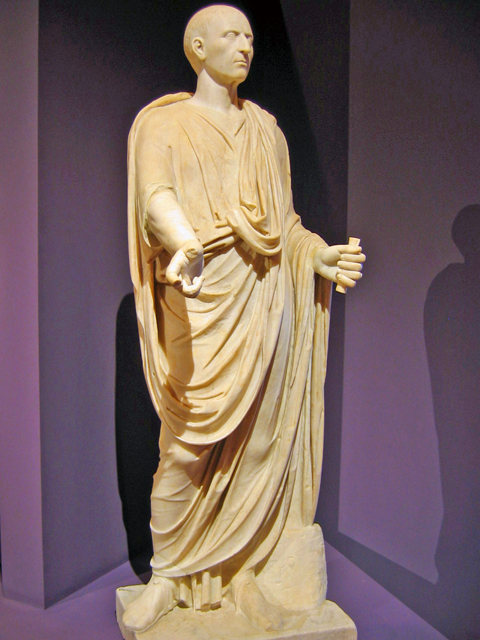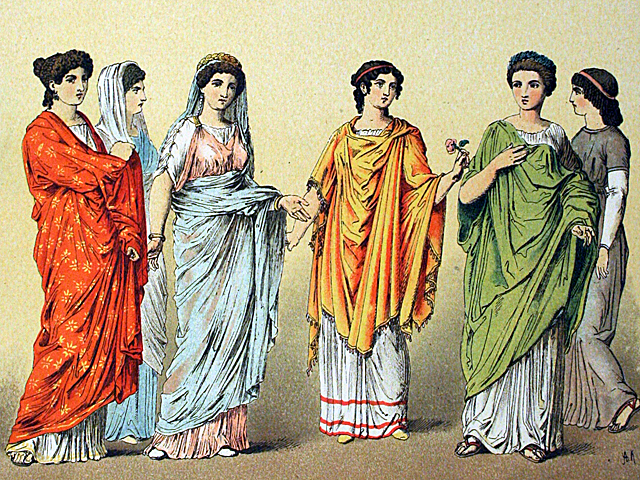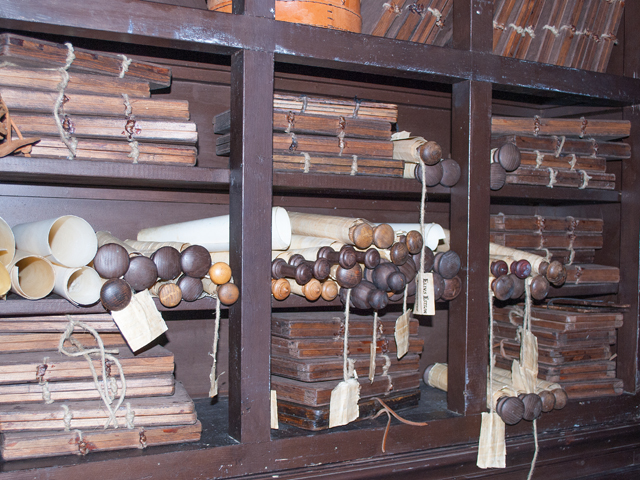Gladiators
Roman Emperors at the “Games”
Like Emperor Commodus (180 to 192). Commodus was popular with the Roman people, especially because he showed himself often and ensured there was enough bread and games (panem et circenses). Because he wanted to reorganize the state finances – which had been strained by his father’s wars – by increasing the senators’ taxes and gave the commanders in the Praetorian Guard a great deal of influence, tensions soon arose with the Senate. It is also possible that the emperor’s love of elaborate public chariot races – as well as private gladiator fights – reported by historical sources might have played a role.
It is questionable, however, whether Commodus himself appeared publicly as a gladiator, as claimed by Herodian and the Historia Augusta and often adopted by modern authors. The most reliable source, the contemporary and eye witness Cassius Dio, reports explicitly (Cass. Dio 73,17,2) that the emperor appeared as a chariot driver and participated in venatio; Commodus only acted privately without an audience as a gladiator and never appeared as one publicly: “Moreover, he used to contend as a gladiator; in doing this at home he managed to kill a man now and then […]. But in public he refrained from using steel and shedding human blood.” The emperor fought publicly in the circus against people armed at most with a wooden sword.
It was mostly during his final years of rule that Commodus engaged in the exalted policies and self-glorification that characterized his legacy. While even before this a month had been renamed in Commodus’ honor, in 192 he renamed all the months after his various honorific titles (with Commodus for April, all the other months also received new names after Commodus such as Lucius or Aelius). Roman legions and other military units received the new name Commodiane, the city of Rome was renamed as Colonia felix Commodiana. In December 192, a conspiracy against the emperor began within his closest circle for unclear reasons. On the last day of the year 192, he was strangled in his bath at court by an athlete named Narcissus. With his death, the Antonine Dynasty, founded by Antoninus Pius, came to an end, and Commodus then received a damnatio memoriae. The Year of the Five Emperors followed.
The History of the Gladiators: The Path to the “Free Gladiators”
The “games” became increasingly important in the Roman Empire. The history of gladiator fights had begun with slaves, criminals, and prisoners of war who were forced into the role of gladiators. This changed throughout the time of the Roman Empire. Starting already in the 1st century, free men also volunteered as gladiators. Some were former soldiers, some wanted admiration and glory, and some needed money to pay their debts. Gladiators were not allowed to keep any prizes or gifts they received during the gladiator fights.
These free gladiators were called Auctorati. Although gladiators were lower than slaves on the social scale, at times interest in becoming a gladiator was so great that the Senate wanted to limit entry with a law. Towards the end of the Republic, for example, almost half of the gladiators were formerly free citizens who gave up their freedom upon their entry into the ranks of the gladiators. This goal can be better understood when taking into consideration the generally short life expectations of the time. A gladiator only had to fight between one and three times per year and was well-cared for the rest of the time. Even some female gladiators (some noble and well-to-do) appeared in the arena. Free gladiators played a surprising role in gladiator history.
The medical treatment gladiators received was exemplary. One of the most famous doctors of antiquity, Galen, collected his experiences during the time in which he cared for fighters at the gladiator school of Pergamon. The historian Fik Meijer even draws parallels between those who volunteered for gladiator service and the nobles who volunteered for service in the French Foreign Legion in the 19th and 20th centuries:
“Their situation can perhaps best be compared with some of the poorer aristocrats of the 19th and 20th centuries who signed up for service in the French Foreign Legion. Just as the legionnaires of the modern times, these Roman aristocrats wanted to get away from their former lives and decided to take on a role in which their previous status was irrelevant. From that point on, they shared their lives with proletariats and slaves who they wouldn’t have spared a glance for previously.”
Gladiator Diversity – Overview of the Types
Gladiators were often divided into different types depending on their weapons and style of fighting. In all, there were almost 30 different gladiators - and 42 different Roman emperors watched the bloodbaths in the Colosseum. The relative rarity of the elaborate and expensive gladiator fights remained mostly constant throughout the centuries. In 354 AD, 102 of the 176 festival days were used for theater performances, 64 for chariot races, and only 10 for gladiator fights. It was Emperor Honorius who ended the gladiator fights in 399. The last known gladiator fight in Rome was on January 1, 404.
In the Roman arenas, a series of different gladiator types that had developed throughout the centuries fought. The allure of the fights lay partially in having the various types fight against one another.
We can attribute most of our knowledge about the gladiators’ weapons from excavations in Pompeii, where a great deal of equipment from gladiator barracks was found. Today, the equipment is in the Museo Archeologico Nazionale in Naples. Statues and representations of gladiators on gravestones, frescoes, reliefs, mosaics, and oil lamps also give clues.
The first gladiators, who performed at funeral ceremonies or burials of noble Romans and were named bustarii after the funeral pyre (bustum), had very simple equipment. Each gladiator carried a shield and sword and was protected by a helmet and greaves. Throughout the centuries, several gladiator types developed which differed greatly from one another in terms of their equipment and fighting styles.
The earlier gladiators probably fought with weapons similar to those of the peoples who had been conquered by Rome. Later, though, a gladiator fighting as a Gaul did not necessarily have to come from Gaul. Because of the sources, the exact equipment of these earlier types is unclear.
Samnite
Livius reports in his work Ab Urbe Condita (9, 40) that the Campanians allied with Rome armed the fighters who performed at their banquets with the weapons of their defeated enemies, in this case the Samnites. According to Livius, they were equipped with a plumed helmet (galea cristata), a long shield, and a left greave.
Gallus
Little is known about the armor of the gladiators who fought under the name of the Gauls.
Types in the Imperial Period
Augustus reformed the gladiators, and types such as Samnite or Gallus no longer appeared. However, he took on older types such as Provocator, Thraex, and Murmillo.
Eques
The Equites opened the gladiator games with their fight. They were armed with a plumed helmet with a visor, a flat, round shield, a lance, and a short sword (gladius). In contrast to all other types of gladiators, who were clothed with only a loincloth (subligaculum), they were tunics. They began their fight on horseback but then dismounted and continued with their swords. In pictorial representations, they are usually shown in the final phase of the fight, that is, on foot and fighting with swords.
Murmillo
The Murmillo is a very old type of gladiator that existed in the first century BC. The armor of the Murmillo, with their short sword (gladius) and large, square shield (scutum) is comparable to the Legion infantry. As protective clothing, they had an armguard (mania) and a greave on their left leg which went up to just below the knee. They wore a visored helmet with a high, straight crest that was decorated with colorful feathers and looked like a fish (mormylos = little fish). They fought against the Thracians.
Thraex
This type of fighter carried a weapon designed to point to his Thracian origins. The Thraex had a sword with the curved blade (sica) and a small, rounded square shield (parmula) and wore a visored helmet with a griffin on the front of the crest. As protective clothing, he wore a quilted armguard (manica). On both legs, he wore quilted thigh-length leg guards, and on top of these were greaves which reached above the knee.
Hoplomachus
As an alternative to the matching of Murmillo against Thraex, there was the matching of Murmillo against Hoplomachus. In weaponry and protective clothing, Hoplomachus was similar to Thraex. Instead of a round shield, he had a very small form of a Greek hoplite round shield as well as a spear (hasta). For close combat, he also had a gladius. In exceptional cases, he could also fight against Thraex.
The Special Retiarius
The Retiarius was an unusual gladiator who was only mentioned starting with the reign of Emperor Caligula (37-41 AD). His exceptional weaponry was made up of a throwing net (rete), a trident (tridens, also called fuscina), and a short sword or dagger (pugio). He had neither a shield nor a helmet. His only protective clothing was a shoulder shield (galerus) and an armguard (manica) on his left arm. At first he tried to throw the net over his opponent. Once it was thrown unsuccessfully, he tried to attack him with the trident; if this failed, he still had the sword for close fighting. His opponent was usually the Secutor.
Pontarius
The Pontarius was a kind of game for the Retiarius. He defended a bridge (pons) with two ramp-like ends. On each side, a Secutor attacked and tried to get up on the platform. In addition to his usual equipment, the shoulder shield (galerus) and the armguard, the Pontarius had a large stockpile of throwing objects, probably rocks.
Secutor
The Secutor (pursuer) was a Murmillo specialized in fighting the Retiarius. In order to avoid his opponent’s attack with the throwing net, he wore an egg-shaped helmet which only had very small eyeholes. This limitation in his vision also protected his eyes from being poked out by the Retiarius. His weapons were the short sword and a large, square shield (scutum).
Scissor
This rare type of gladiator could fight against Retiarius. Just as the Secutor, he had an egg-shaped helmet with eyeholes, he also carried the short sword (gladius) in his right hand, and his right arm was also protected by an armguard. The special characteristic of the Scissor was that he had no shield, and instead his left arm was put in a rounded tube that encased his entire lower arm. At the end of the tube was a short shaft with a blade shaped like a mincing knife. With this weapon, he could cut the Retiarius’ net or parry his trident. He could also cut open his opponent with a slice of the blade. As he couldn’t protect his body with a shield, he wore knee-length chainmail called lorica hamate or scale armor (lorica squamata).
Provocator
The Provocator (Challenger) is known starting in the late Republic and fought, like Equites, against others of his type. In the 1st century AD, he wore a helmet similar to a legionary helmet. Only in the 2nd and 3rd centuries did he have a helmet without a crest and with a steeply descending neck guard but with a visor. He was armed with a mid-sized square shield (scutum), a crescent-shaped breastplate (pectoral), and a gladius. As protection, he had a greave on his left leg and a manica on his right arm.
Gladiatrix
There were a few women who fought in the arena, although it was hardly commonplace. A relief from Halicarnassus (Turkey) shows their equipment. They could have fought in all types, but the two female gladiators (gladiatrices) shown are equipped the same as the Provocators.
Essedarius
The Essedarius was another type of gladiator that only fought against its same type. The name is derived from the term for a Celtic chariot (essedum). It is assumed that the Essedarii opened the fight on their chariots and then, similar to the Equites, dismounted and continued the fight on foot. The Essedarius had an armguard on his swordarm, a short sword, and gaiters or short bandages on both legs. In addition, he wore a helmet which in early times was similar to a legionary helmet and later to the Secutor helmet.
Very Rare Gladiators
There were also other types of gladiators who are mentioned only rarely. For example the Dimachaerus, who fought with two blades, that is, daggers or swords like the gladius. He wore padded protection on his body, bandages on his dagger arm and on the legs, and sometimes also greaves, but no helmet. His name is made up of the Greek words for “two” (dio) and “knives” (machaera). The Sagittarius (archer) is only depicted on a relief in Florence where two armed and helmed archers shoot at each other in an arena. Andabates is mentioned by Cicero but does not appear again in the imperial period. His eyes were bound, and he therefore had to rely on his hearing since only the reaction of the crowd or the sounds of breathing could give him clues as to where his opponent was located. Laquearius (lasso fighter) was only mentioned by Isidor of Sevilla. There is also little known about Paegniarius.
The Paegniarius was not armed with deadly weapons. A scene on a mosaic in Nennig is often interpreted as a representation of this type of gladiator. The fighters carry a whip in their right hand and a wooden board bound to their left arm. According to a description from Sueton, Emperor Caligula had fathers with physical handicaps fight as gladiators in the arena for entertainment. Since there are Roman representations of people of small stature with all types of weapons, these may have also appeared as Paegniarii with dulled weapons for entertainment. It is likely that the Paegniarii appeared in preliminary fights (prolusion) and venatio.
The Veles, on the other hand, was a type mentioned only by Isidor of Sevilla as well as in several inscriptions with the abbreviation VEL. The name comes from the most poorly armed Roman soldiers, velites (skirmishers), during the time of the Punic Wars. It is assumed that their style of fighting was similar to this type of soldier. The Crupellarius was mentioned by Tacitus as a Gallic fighter. A bronze statuette from France could be a representation of this fully armored fighter. The Scaeva was a gladiator who fought left-handed. Emperor Commodus, who like to privately fight as a gladiator – not in the arena -, fought as a secutor scaeva. If two left-handed gladiators were matched, it was called a left-handed fight (pugna scaevata). The Venator fought against wild animals. That is why it does not belong in the true gladiator typologies.




